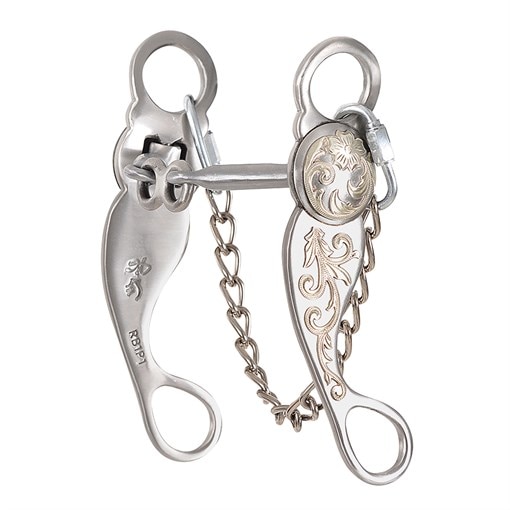A Full Cheek Bit is a type of horse bit that provides extra control and helps with steering. It has elongated cheekpieces that extend above and below the mouthpiece, with a ring at the end of each cheekpiece to attach the bridle.
The extended cheeks help to prevent the bit from sliding through the mouth, providing added stability and control. Full cheek bits are commonly used in English riding disciplines, such as dressage and show jumping, to aid in lateral movements and to encourage the horse to respond to subtle rein aids.
In the world of horse riding and training, different types of bits are used to communicate with the horse and guide its movements. One such bit is the Full Cheek Bit. Designed with elongated cheekpieces that extend above and below the mouthpiece, this bit provides extra control and steering assistance. By preventing the bit from sliding through the horse’s mouth, the full cheek bit offers stability and helps in maintaining a proper rein contact. This type of bit is commonly used in English riding disciplines like dressage and show jumping to encourage the horse to respond to the rider’s subtle rein aids and aid in lateral movements. We explore the features and functions of the Full Cheek Bit.

Benefits Of Using A Full Cheek Bit
When it comes to horse riding equipment, the choice of bit can greatly impact the horse’s performance and overall experience. One popular option is the full cheek bit, which offers several benefits for both the rider and the horse. In this section, we will explore the advantages of using a full cheek bit, including enhanced steering and control, and the prevention of lateral movement.
Enhanced Steering And Control
One of the key benefits of using a full cheek bit is its ability to provide enhanced steering and control. The design of the full cheek bit includes elongated “cheeks” on either side of the mouthpiece, which can be attached to the bridle using bit keepers. These cheeks serve as leverage points, allowing the rider to have more precise control over the horse’s head and direction.
With the added leverage, riders can communicate their cues more effectively, making it easier to guide the horse during turns, transitions, or intricate maneuvers. This can be particularly beneficial in disciplines such as dressage or jumping, where precise steering and control are crucial for success.
Prevention Of Lateral Movement
Another advantage of using a full cheek bit is its ability to prevent lateral movement. The extended cheeks of the bit help to keep the horse’s head in place and discourage excessive side-to-side motion. This can be especially useful for horses that tend to lean on the bit or evade direct contact.
The full cheek bit’s design acts as a gentle reminder to the horse to stay straight and maintain a steady connection with the rider’s hands. By reducing lateral movement, riders can improve their horse’s balance and overall responsiveness, leading to a more harmonious partnership and better performance.
In addition to better steering and control, the prevention of lateral movement offered by the full cheek bit can also contribute to improved safety. By keeping the horse’s head and neck aligned, riders can minimize the risk of sudden head movements or loss of control, ensuring a safer riding experience for both horse and rider.
Overall, the full cheek bit provides various benefits, including enhanced steering and control, as well as the prevention of lateral movement. These advantages make it a popular choice among riders looking to improve their communication and connection with their horses. However, as with any piece of horse equipment, proper fitting and training are essential to ensure optimal results and horse comfort.

Types Of Full Cheek Bits
A Full Cheek Bit is essential for proper communication and control while riding. These bits feature elongated cheekpieces to aid in guiding and preventing lateral movement. Varieties like rubber-covered and double-jointed options cater to diverse riding preferences.
Variety Of Mouthpieces
When it comes to full cheek bits, there is a wide variety of mouthpieces available to suit different horse preferences and levels of training. The mouthpiece is an important part of the bit that sits inside the horse’s mouth and comes into direct contact with their tongue and bars.
1. Single Jointed: This type of mouthpiece has a joint in the center, creating a nutcracker action when the reins are pulled. It applies pressure to the tongue and bars, encouraging the horse to respond to rein aids.
2. Double Jointed: Also known as a French link, this mouthpiece is designed to eliminate the nutcracker action, providing a more comfortable fit for the horse. It allows for better communication between the rider’s hands and the horse’s mouth.
3. Mullen Mouth: This mouthpiece is straight and does not have a joint. It applies even pressure across the tongue and bars, making it a good option for horses with sensitive mouths or those who don’t respond well to jointed mouthpieces.
4. Twist: The twist mouthpiece has a twisted design that provides more pressure and control. It is often used for horses that require a stronger bit, but should be used with caution as it can be harsh if overused or misused.
5. Copper or Sweet Iron: Some full cheek bits have a copper or sweet iron mouthpiece. These materials encourage salivation and can make the bit more palatable for the horse. Copper and sweet iron also have a natural warmth that can help relax the horse’s jaw.
Remember, every horse is different, and finding the right mouthpiece may require some trial and error. It’s important to consider your horse’s individual needs and preferences when selecting a full cheek bit.
Need For Additional Bit Keepers
When using a full cheek bit, it is essential to ensure that the bit remains correctly positioned in the horse’s mouth. To prevent the bit from sliding through the mouth and to provide stability, additional bit keepers can be used.
Bit keepers are small leather loops that attach to the sides of the bit and then connect to the bridle’s cheekpieces. They help to keep the bit in place and prevent it from rotating or sliding through the horse’s mouth.
Using bit keepers is especially important when riding with a loose or dropped rein, as it provides greater stability and control. It is crucial to adjust the bit keepers correctly to ensure they are not too loose or too tight, as this can cause discomfort or interfere with the horse’s natural movement.
By using additional bit keepers, you can ensure that your full cheek bit remains secure in your horse’s mouth, providing effective communication and control during riding sessions.
(In the table below, I have summarized the different types of full cheek bits and their mouthpiece options for easy reference.)
| Full Cheek Bit Type | Mouthpiece Options |
|---|---|
| Single Jointed | Creates a nutcracker action |
| Double Jointed (French Link) | Eliminates the nutcracker action |
| Mullen Mouth | Straight, even pressure |
| Twist | Provides more pressure and control |
| Copper or Sweet Iron | Encourage salivation and warmth |
Remember to always consider your horse’s individual needs and preferences when selecting a full cheek bit with the appropriate mouthpiece.
Choosing The Right Full Cheek Bit
When it comes to choosing the right full cheek bit for your horse, there are several factors to consider. From the horse’s mouth anatomy to the material of the bit, every aspect plays a crucial role in ensuring the comfort and effectiveness of the equipment. Here’s a guide to help you make an informed decision when selecting the perfect full cheek bit for your equine companion.
Consideration For Horse’s Mouth Anatomy
The horse’s mouth anatomy is a crucial factor to consider when selecting a full cheek bit. Each horse has a unique oral structure, and it’s essential to choose a bit that fits comfortably and does not cause any pain or discomfort. Ensuring the right size and shape of the bit is crucial to promote better communication between the rider and the horse. It’s essential to assess the horse’s mouth carefully and, if necessary, seek professional advice to determine the most suitable full cheek bit for your horse.
Selecting The Appropriate Material
Choosing the appropriate material for the full cheek bit is essential for both durability and the comfort of the horse. The most common materials for full cheek bits include stainless steel, copper, and sweet iron. Stainless steel is a popular choice for its durability and low maintenance, while copper and sweet iron bits are known for their ability to encourage salivation and promote a softer mouth. Understanding the benefits of each material and considering your horse’s preferences can help you select the most suitable option.
Caring For Full Cheek Bits
To ensure the longevity and effectiveness of your full cheek bit, regular cleaning and maintenance are essential. Here are some tips:
- After each use, rinse the bit with warm water to remove any dirt or debris.
- Use a gentle bit cleaner or mild soap to clean the bit thoroughly.
- Dry the bit completely before storing to prevent rust or corrosion.
- Inspect the bit for any signs of wear or damage regularly.
If you notice any worn out components on your full cheek bit, it is important to replace them promptly. Here are some steps to follow:
- Check the bit for signs of wear such as sharp edges or rust.
- Replace broken or damaged cheek pieces, mouthpieces, or any other worn-out components.
- Consult a professional if you are unsure about how to replace any parts.
- Regularly inspect and maintain your full cheek bit to ensure optimal performance.

Frequently Asked Questions Of Full Cheek Bit
What Does A Full Cheek Bit Do?
A full cheek bit provides lateral control and helps in steering. It prevents the bit from sliding through the horse’s mouth.
Is A Full Cheek Snaffle Harsh?
No, a full cheek snaffle is not harsh. It provides additional control and helps with steering.
Do Full Cheek Bits Need Keepers?
Yes, full cheek bits require keepers to stabilize and prevent the bit from rotating in the horse’s mouth.
What Is The Kindest Bit For A Horse?
The kindest bit for a horse is usually a snaffle bit with smooth and gentle action.
Conclusion
Full cheek bits are a valuable tool for ensuring precise communication with your horse while providing gentle guidance. Whether you are a novice rider or an experienced equestrian, the full cheek bit can enhance your control and aid in steering.
The added lateral control offered by this bit is advantageous in various riding disciplines, making it a versatile choice for your equine partner. As you explore the diverse options available, consider the unique needs of your horse to find the best full cheek bit for a harmonious ride.

